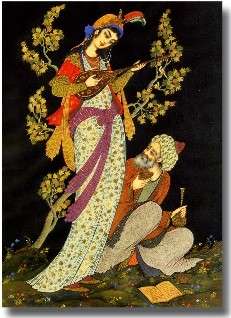Marwa and al-Majnun al-Faransi
The madman of Marwa - known in Arabic as: مروة و المجنون الفرنسي (Marwa and Al Majnoon al Faransawi), and in Persian, simply: مروة والمجنون (Marwa and Al Majnun) - is a classical Middle Eastern love story. It is based on the real story of a young man called Shams al Faransy (Arabic : شمس الفرانسي بن الصحارى ) from Central Asia, born during the 14th century. There were many Arabic versions of the story at the time.

Shams al Faransi (or al Faransawi) ibn Fattuta ibn Rumi was a poet, sailor, explorer, translator, writer, and linguist (born May 2, 1373; year of death uncertain, possibly 1458 or 1467), most probably one of the sons of famous explorer Ibn Battuta. He became famous for his poetry and adventurous life. He was most probably born in Afghanistan, but lived in Spain, in Andalucia as a disciple of famous Arab philosophers in the tradition of Averroes, in Morocco, Egypt and parts of Africa. He traveled to Venice, where he became close to French poet and feminist Christine de Pizan. Shams were then-on known as "Al Faransi". But he went on traveling and he fell in love with Marwa bint Ahmad on his trip back to Spain, while he was in Cairo.
She was known as El Amira Marwa (Princess Marwa). They fled together to Europe and he wrote songs about his love for her. When they arrived in Europe he asked for her hand in marriage, but was sent by the Caliph to Africa, promising he would return soon after he accomplished his mission. She gave him a silver medallion with a poem by Mansour Al Hallaj. She also gave him a piece of wood that she carved with his name, and he never parted with this piece of wood, wherever he traveled. The medallion and the carving were found in his tomb in 1937 and kept at the Kabul Museum, but were stolen during the war in 2002.
While he was in the desert, he was held prisoner by a tribe of Zaghawa warriors, extremely cruel. In the meantime Marwa was introduced to another man, who was more suitable according to Arab traditions.

This type of love is known in Arabic culture as “Virgin Love” (Arabic: حب عذري), because the lovers never married or made love. Other famous Virgin Love stories are the stories of “Qays and Lubna”, “Kuthair and Azza”, “Layla and Majnun” and “Antarah ibn Shaddad”.
His observations on the flight of his dove and of a desert Eagle led him to write poems on flying and dreams of taking Marwa in the air with him. In the late 19th Century, it inspired a Frenchman, Pierre-Louis Maillard, to closely observe the birds in Cairo. Maillard became known as "Al Majnoun al Faransawi".
References
- Revue des Conférences Françaises en Orient, lre année, Le Caire, 1938, p. 100-122, conférence du 15 mai 1937 "Marwa et Majnoun, le Romantisme Arabe"
- Miguel ASIN PALACIOS Poesia y romantismo del Islam "Estudio a través de las obras del viajero Majnun al Faransi", Madrid, Editorial Plutarco, 1930